
A traditional Maori meeting house under a starlit sky. Photo: Matariki.co.nz
The end is nigh.

Roy Pilott
The future of Māori wards around the country goes to the vote in October, and I’ll be shocked if they do not get the thumbs down.
A decade ago New Plymouth voters snookered plans for a Māori ward by 83 per cent to 17 per cent. Māori make up 15 per cent of the population. Go figure. That’s one reason why the Labour led government removed the power of veto from voters and handed the final call to councils.
Some – like South Waikato and Waitomo – decided they did not need them because they were comfortable they already had strong Māori representation.
That’s not the case in Waipā. The first comment from someone looking at candidates on our Cambridge News front page last week was “wow, look at all those white faces”.
A couple of days earlier, a Cambridge resident in a retirement village told me he doubted more than one in 100 there would support keeping the wards.

The first Maori ward election was held in 2022
The News supports Māori wards. The advantages of having a Te Ao Māori (that’s Māori world) voice at the table far outweighs any illogical cry that it’s not democratic.
I believe those who argue we are all the same and all one usually do so from a privileged perspective, and despite some of their best friends being Māori, have never made an effort to embrace the Māori culture, to the point of bring proud about it.
I am also disappointed that in the wake of the new Government’s referendum edict on existing Māori wards, the councillors in those seats appeared to do so little to demonstrate their value to the 85 per cent of voters who are not in their electorates.
Interest in the Waipā Māori ward appeared so low that one candidate put her name forward because incumbent Dale-Maree Morgan had not. She did, on the last day of nominations.
Those candidates are campaigning for the seat – and like it or not, they should also be campaigning to save the seat.
They should not expect the media to do the job of publicising the seat’s value, though we will.
Indeed, outside of the Good Local Media region, national media interest in these elections is limited to what is sadly known as click bait. So Don Brash and his anti-Māori ward Hobson’s Pledge scored massive publicity last week by using a photograph of a Rotorua kuia and applying a caption suggesting she opposed the seats.
Of course, Māori can stand for election. But think of the 83-17 vote when you consider the chances of a Māori candidate’s chances. Perhaps that is one reason local government and local governors have never convinced Māori of the value of their vote.
To those in the 85 per cent who have already decided to vote against the wards – would you have the same view if you were in the 15 per cent?
Take this into account too – in not too many generations from now, 15 per cent of the population might be campaigning for a Pakeha seat on these councils.
During the election campaign we’ll seek the views of candidates on Māori wards and invite some of the players in their introduction three years ago to give their views.

Local body elections








